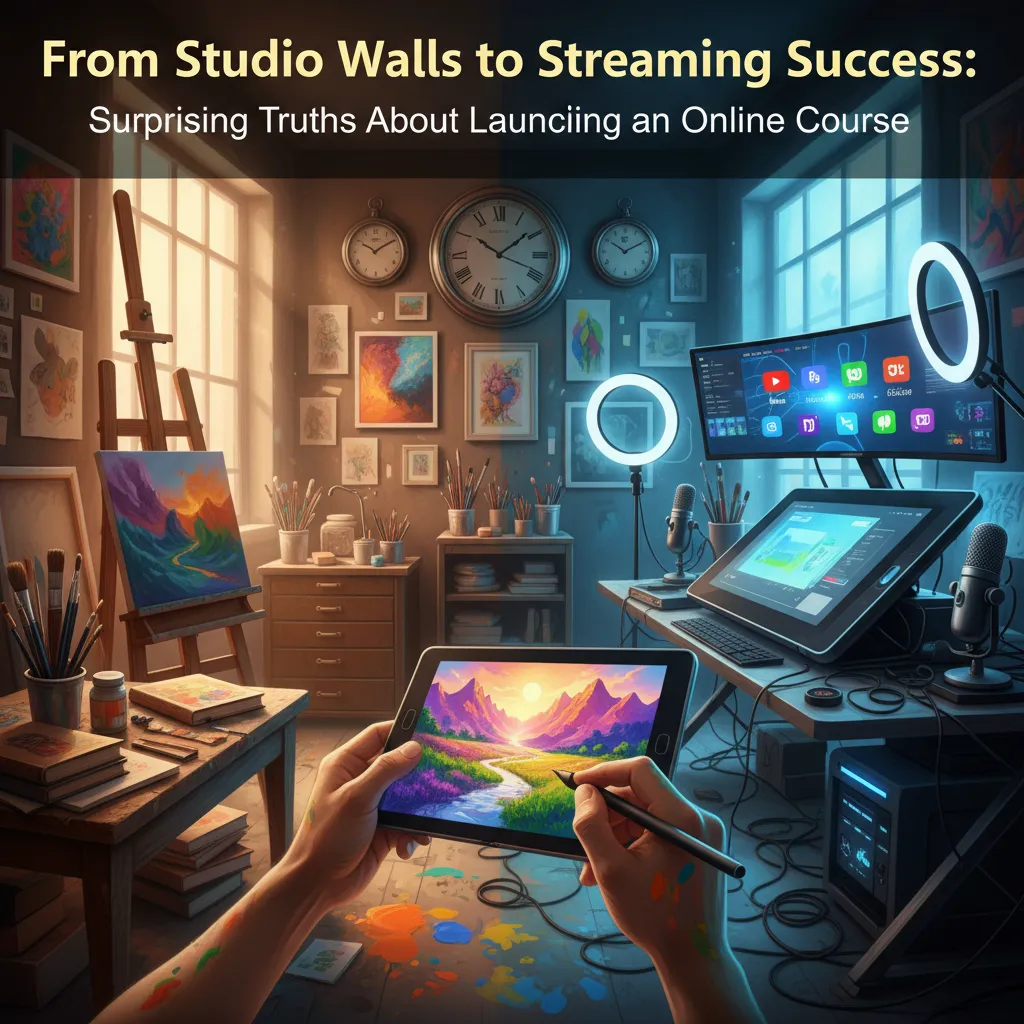Picture this: You’re in a cramped music studio teaching scales on repeat, wishing you could clone yourself. That was Lauren Baitman’s reality—until a late-night YouTube upload flipped the script. I know, because not so long ago, I was stuck in my own expertise echo chamber, wondering if forging an online course was a leap or just a shiny new distraction. (Spoiler: it’s a little of both, and that’s where the magic happens.)
Confessions of a Course Creator: Why Most First Launches Flop (And Why That’s Not the End)
Let’s get honest about how to create an online course: the first time you launch, you’ll probably flop. Not because you’re not talented or passionate, but because the myth of overnight success is just that—a myth. Lauren Baitman’s story is proof. She poured her heart into her very first beginner guitar course, launching it in November 2017. The result? Two sales. Not two hundred. Not even twenty. Just two. And yet, that tiny number was the spark for everything that followed.
The Myth of Overnight Success: Two Sales and a Dream
When you’re deep in mini-course development, it’s easy to imagine that once you hit “publish,” the world will beat a path to your virtual door. Lauren’s experience was different. She remembers,
"I released it to two sales, which, you know, hey, that was great for me at the time, but, you know, it wasn't, you know, a windfall of sales."
Her course was priced at $297—a bold move when others in her niche were charging $10 to $20. It wasn’t about undercutting the competition, but about valuing her expertise. Still, the sales didn’t flood in. If you’re wondering how to create an online course that actually sells, Lauren’s story is a reminder: your first launch is rarely your best. And that’s okay.
Stumbling Through Technical Hiccups: The Lore of Early Imperfection
Lauren’s first course wasn’t just light on sales—it was heavy on technical hiccups. She recorded in her studio, then came home to edit. The lighting was dim, the audio was quirky, and the camera angles wobbled. She laughs about it now, but at the time, it felt like every little flaw was a neon sign pointing to her inexperience. She admits,
"My biggest mistakes were the lighting and the audio wasn't greatest on like the first iteration of my course. Um but eventually those are things you can fix."
Here’s the surprising truth: these early stumbles are part of the lore. They’re the stories you’ll tell later, the badges of honor you’ll wear when you’ve found your stride. In the world of content quality in online courses, perfection is less important than progress. The tech world calls this the “ship it” mindset—get your product out, then improve it. (Remember the original Xbox launch? It was famously buggy, but Microsoft kept iterating.)
Reframing ‘Failure’ as a Milestone: The Power of Iterative Improvement
Every course creator faces the same question: what if nobody buys? What if the lighting is bad, or the audio is fuzzy? The answer is simple: that’s how you learn. Lauren’s two sales weren’t a failure—they were a milestone. Each time she fixed a technical issue, clarified a lesson, or restructured a module, her course got better. This is the heart of iterative improvement in course design:
- Launch your course, even if it’s imperfect.
- Gather feedback from your brave first students.
- Fix one thing at a time—lighting, audio, structure.
- Re-release, and watch your confidence (and sales) grow.
Lauren’s journey is proof that “done” is better than “perfect.” Every stumble sharpened her skills. Every awkward video or unclear lesson became a stepping stone. In her words,
"Content is king, you should do pretty good."
Wild Card Anecdote: Wearing Your Tech Gremlins Like a Badge
Let me confess: my own first online webinar had more tech gremlins than attendees. The slides wouldn’t load, my mic cut out, and I spent half the session apologizing to the three people who stuck around. At the time, I wanted to crawl under my desk. Now, I wear that disaster like a badge of honor. It taught me more about mini-course development tips and resilience than any polished launch ever could.
If you’re staring down your first launch, remember: every course creator has their own “two sales” story. The only real mistake is giving up before you’ve had a chance to improve. Embrace the mess, fix what you can, and keep going. That’s how you turn studio walls into streaming success.

The ‘Choose-Your-Own-Adventure’ Guide to Validating a Profitable Course Topic
Venturing into Facebook Groups: Where Profitable Course Topics Are Hiding
Imagine you’re standing at the edge of a treasure map, but instead of “X marks the spot,” you’re staring at a Facebook group full of real people with real struggles. This is where your adventure begins. If you want to choose a profitable course topic, forget guessing. Instead, do what Lauren recommends:
“Go find a Facebook group...and just go in the comments and see the questions people are asking.”It’s simple, but it’s gold. Whether your expertise is beginner guitar, weight loss, or watercolor painting, there’s a group for it. Lurk in the comments. Scroll through the threads. You’ll start to notice the same questions popping up again and again—these are the pain points people are desperate to solve.
Listening Beats Guessing: Let Honest Learner Pain Points Guide You
Here’s the truth: your best course ideas don’t come from brainstorming in a vacuum. They come from listening. Audience-driven validation is the secret sauce for uncovering in-demand, profitable course topics. When you see a question asked for the tenth time—like “How do I switch chords without pausing?” or “What’s the best way to meal prep for beginners?”—you’ve struck oil.
Make a list of these recurring struggles. Don’t just skim—copy and paste the actual questions into a doc. This is your raw material. These pain points are your North Star. If you can solve one of these problems, you’re not just creating a course; you’re creating a solution people are already searching for.
Key Question: Can Your Course Deliver a 90-Day ‘Mini-Win’?
Now, ask yourself the magic question:
“What would be the first 90-day transformation they have to go through to feel like they would have a win?”This is where transformational learning in online courses comes alive. People don’t want a vague promise—they want a clear, achievable outcome. Lauren’s first course, launched in March 2017, was all about the first three months of learning guitar. The goal? Teach total beginners a few simple chords, some basic strumming, and get them playing real songs. That’s a win anyone can picture.
A short, specific promise—like a 90-day transformation—drives enrollments. It’s not about overwhelming your students with everything you know. It’s about mapping out the first steps, the quick wins, and the confidence boost that comes from real progress.
Personal Tangent: My Genius Idea That Flopped (and What I Do Now)
Let me share a secret: I once built a course on a topic I thought was genius. I spent weeks outlining, filming, and editing. I launched it to my list… and heard nothing but crickets. Why? Because I never checked if anyone actually wanted it. I didn’t listen—I guessed.
Now, before I create anything, I troll Reddit, Facebook Groups, and even YouTube comment sections. I look for the questions people are asking, the frustrations they’re venting, and the “I wish someone would just show me how to…” posts. It’s humbling, but it works. Every time I build a course around a real, recurring pain point, it sells.
How to Use Facebook Groups for Course Validation: A Step-by-Step Mini-Adventure
- Join 3-5 groups related to your expertise (beginner-focused groups work best).
- Lurk and listen—don’t pitch, just observe. Note the questions and struggles that come up repeatedly.
- Copy real questions into a doc. Look for patterns and themes.
- Ask yourself: Can I help someone achieve a clear, specific win in 90 days?
- Test your idea—post a poll or ask for feedback on your proposed transformation. See who bites.
Pro Tip: The Beginner’s Journey Is Your Best Bet
Lauren’s approach—mapping out the first 90 days for a total beginner—is a winning framework. It’s easier to validate, easier to sell, and gives your students a clear finish line. If you can take someone from “I know nothing” to “I can do this!” in three months, you’ve got a course worth launching.

Ship, Learn, Grow: The Art (and Anxiety) of Imperfect Launches and ‘Ship It’ Mindset
When you’re learning how to create an online course, it’s easy to get trapped by the myth of perfection. You might spend months tweaking slides, recording and re-recording videos, or obsessing over every detail of your curriculum. But here’s the truth: the most successful online educators don’t wait for flawless. They “ship it”—launching their course before it’s perfect, and then improving it with every round. This is the heart of the ‘Ship It’ mindset, a business approach that values action, execution, and iteration over endless analysis.
If you’ve ever listened to a business podcast, you’ve probably heard the phrase:
"Ship it. It's a business mindset that prioritizes action, execution, iteration, and really launching your project even though it's not flawless."The idea is simple but powerful: done is better than perfect, and speed beats stalling. This mindset isn’t just for tech startups—it’s the secret sauce behind many thriving online courses. Let’s look at a surprising example from the world of gaming: the original Xbox.
When Microsoft decided to enter the gaming market, they were up against giants like Sony and Nintendo. They had never built a console before, and their first attempt was far from perfect. The original Xbox launched with buggy software, frequent crashes, and a limited game library. In fact, Microsoft lost money on every console sold. But they didn’t let those flaws stop them. Instead, they listened to feedback, fixed bugs, expanded their game offerings, and built trust with their audience. Fast forward to today, and Xbox is a household name—proof that iterative improvement in course design (or any product) can win the long game.
Launching your online course is a lot like teaching your first group lesson. You might forget half your talking points, stumble over your words, or realize you missed a key resource. But with each round, you get better. You learn what resonates with your students, what needs more clarity, and what can be improved. The anxiety of that first imperfect launch is real—but it’s also the gateway to growth.
Lauren, who’s built a multi-million dollar course business (over $3 million in sales), knows this journey well. In her own words:
"Get the product out there. Make some money. You can always always improve upon it."In the early days, she replied to every email herself, handled every tech issue, and personally welcomed every student. But as her business grew, she realized the importance of outsourcing for online educators. She hired editors, delegated customer service, and automated her systems. This shift didn’t just free up her time—it allowed her to focus on what mattered most: listening to her audience and refining her course based on real feedback.
This is the magic of iterative product development. When you launch, you get real-world data. You see where students get stuck, what lessons they love, and what needs to be reworked. You can create new versions, add bonus materials, or even pivot your entire offer based on what your audience wants. Perfectionism might feel safe, but it’s a trap that keeps your course—and your business—stuck behind closed doors.
So, if you’re hesitating to launch because your course isn’t “ready,” remember the Xbox story. Remember Lauren’s journey from solo creator to successful entrepreneur. The most important step is to ship—to get your course out there, learn from your students, and grow with every iteration. You don’t have to do it all alone, either. Building a team, even if it starts with just one virtual assistant or editor, is the secret weapon for sustainable scaling.
In the end, launching an online course isn’t about getting it perfect the first time. It’s about having the courage to act, the humility to learn, and the resilience to grow. The ‘Ship It’ mindset isn’t just a business strategy—it’s the foundation of every successful online educator. So take a deep breath, hit publish, and remember: you can always improve upon it.
TL;DR: If you’ve been circling the idea of packaging your knowledge into an online course, heed these unpredictable lessons: validate first, aim for transformation not perfection, and let your first course be gloriously imperfect. Start small, listen, refine, and let your audience guide the evolution. Success isn’t a straight line—it’s a jam session.



